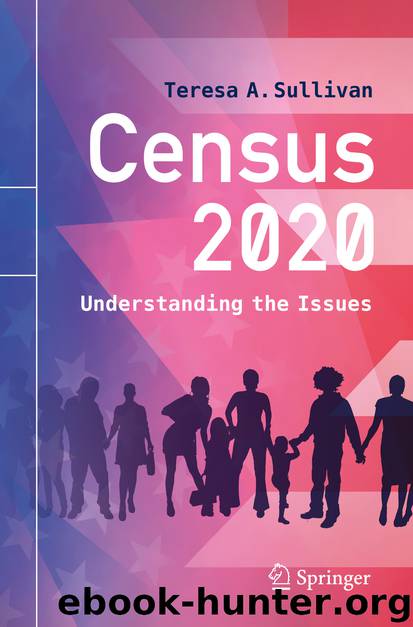Census 2020 by Teresa A. Sullivan

Author:Teresa A. Sullivan
Language: eng
Format: epub
ISBN: 9783030405786
Publisher: Springer International Publishing
4.2 What About Citizenship?
The United Nations recommends citizenship as one of the questions to be asked in a census. The United States’ stance on asking this question has varied over the years. In the 1950 Census, households were asked where each household member had been born. Question 14 read, “If foreign born, is the person naturalized?” This is not quite a citizenship question, because there are situations that could be covered by the combination of being born abroad but not naturalized. Someone born abroad to U.S. parents, for example, would have been born a citizen and not naturalized.
Since 1950 there has been no citizenship question asked of every household (U.S. Census Bureau n.d.).13 In the 1960 Census, one in every four households completed the long form and were asked place of birth; birth country of the person’s father; and birth country of the person’s mother. Question 9 was “If foreign born, what is the person’s mother tongue?” So, the question asked of the foreign-born became a language question and not a naturalization question. The additional questions allowed the analyst to determine the number of immigrants and the number of respondents who were the children of immigrants.
In 1970, once again only the households answering the long form were asked about place of birth. There were two versions of the long form, one for a 5% sample and one for a 15% sample, and questions asked in both samples could yield a 20% sample. Sample respondents were asked for place of birth, Hispanic origin, country of birth for the person’s father and mother, and for persons born in a foreign country, whether they were naturalized and when they had come to the U.S. to stay. There was also a question about mother tongue. The naturalization question was similar to the question asked in 1950, but it was asked only for a sample of households.14
A direct question about citizenship made its debut in the 1990 long form. Although the question was still asked of only a sample of the population, in 1990 and 2000 the question shifted from naturalization to citizenship. In 1990 and 2000, the question asked of a sample of households was “Is this person a citizen of the United States?” (The U.S. Census Bureau n.d.).15
Why did the Census Bureau stop asking everyone about citizenship after the 1950 Census? One procedural history of the census suggests that the reason was because census personnel believed that they could get adequate information from the alien registration forms that were required in those years before the 1965 Amendments.16 The Immigration and Nationality Act of 1952 (the McCarran-Walter Act) required aliens to register once a year. The former Immigration and Naturalization Service (now ICE) also had records on immigrant entries and exits and also on the number of immigrants who were naturalized, and so the information was in principle available from administrative sources.
When undocumented immigrant flows increased in the 1970s and 1980s, the decision not to ask a citizenship question began to look more dubious.
Download
This site does not store any files on its server. We only index and link to content provided by other sites. Please contact the content providers to delete copyright contents if any and email us, we'll remove relevant links or contents immediately.
| Biomathematics | Differential Equations |
| Game Theory | Graph Theory |
| Linear Programming | Probability & Statistics |
| Statistics | Stochastic Modeling |
| Vector Analysis |
Weapons of Math Destruction by Cathy O'Neil(5029)
Factfulness: Ten Reasons We're Wrong About the World – and Why Things Are Better Than You Think by Hans Rosling(4014)
Factfulness_Ten Reasons We're Wrong About the World_and Why Things Are Better Than You Think by Hans Rosling(2751)
Descartes' Error by Antonio Damasio(2728)
A Mind For Numbers: How to Excel at Math and Science (Even If You Flunked Algebra) by Barbara Oakley(2688)
TCP IP by Todd Lammle(2633)
Applied Predictive Modeling by Max Kuhn & Kjell Johnson(2474)
Fooled by Randomness: The Hidden Role of Chance in Life and in the Markets by Nassim Nicholas Taleb(2407)
The Book of Numbers by Peter Bentley(2400)
The Tyranny of Metrics by Jerry Z. Muller(2397)
The Great Unknown by Marcus du Sautoy(2179)
Once Upon an Algorithm by Martin Erwig(2141)
Easy Algebra Step-by-Step by Sandra Luna McCune(2110)
Practical Guide To Principal Component Methods in R (Multivariate Analysis Book 2) by Alboukadel Kassambara(2087)
Lady Luck by Kristen Ashley(2067)
Police Exams Prep 2018-2019 by Kaplan Test Prep(2028)
Linear Time-Invariant Systems, Behaviors and Modules by Ulrich Oberst & Martin Scheicher & Ingrid Scheicher(1980)
All Things Reconsidered by Bill Thompson III(1957)
Secrets of Creation, Volume 1: The Mystery of the Prime Numbers by Watkins Matthew(1858)
